Graceful clematis Miss Bateman - the subtleties of care
Miss Bateman's exotic clematis transforms any garden plot into a magical oasis. The shrub, planted along the vertical structures, amazes with its extraordinary beauty pale milky buds. However, this variety fell in love not only because of its high decorative qualities. The plant has low maintenance requirements and can grow in one place, delighting its owners with abundant flowering, up to 20 years.
- Description of the plant
- Landing features
- Seat selection
- Preparation of planting material
- Soil requirements
- Landing technology
- Care
- Top dressing
- Watering
- Loosening and mulching
- Pruning
- Shelter for the winter
- Reproduction
- Cuttings
- Layers
- By dividing the bush
- Diseases
- Pests
- Use in landscape design
- Testimonials
- Useful videos
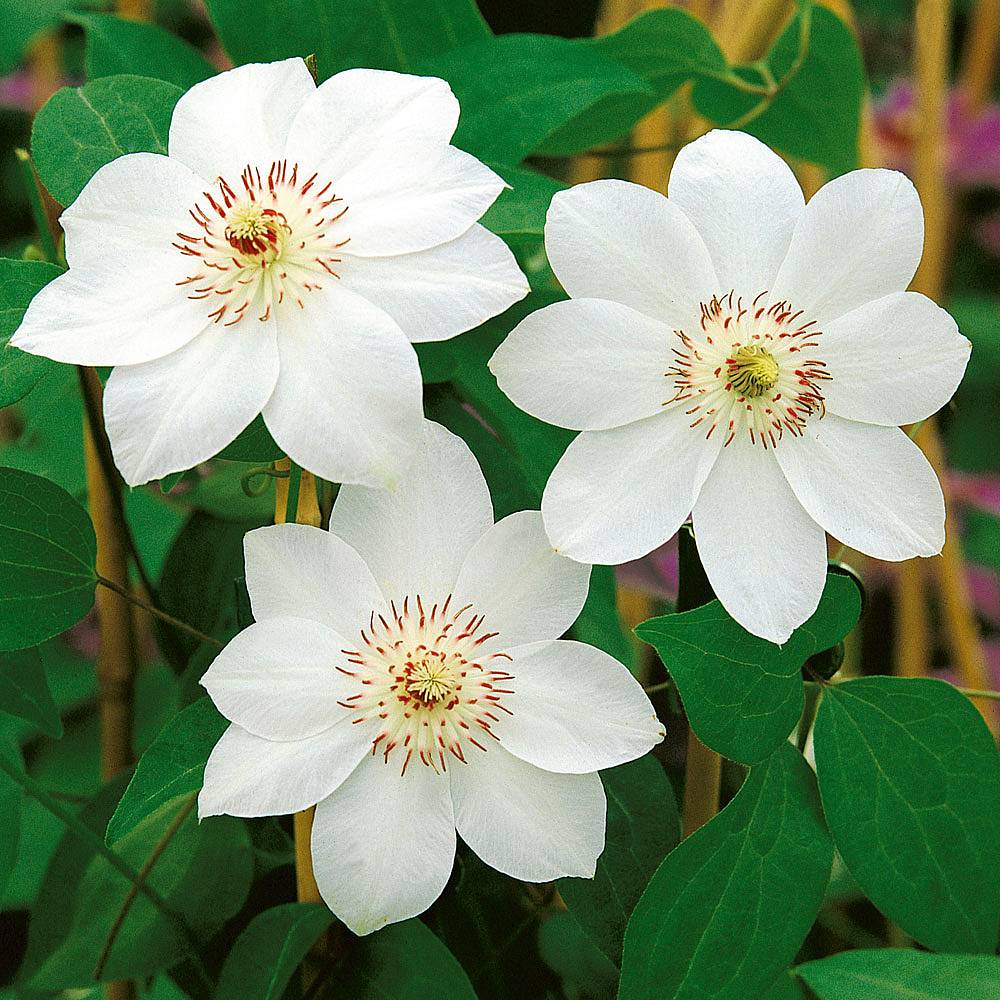
Miss bateman clematis description
Description of the plant
The hybrid Clematis variety Miss Bateman grows up to 2.5-3 m in height, while, thanks to the liana-like shoots, it quite actively fills the entire side space, provided it is planted along the fence. At the age of 3, the branches become denser and, due to the accumulation of specific substances, gradually grow stiff.
Leaves are medium, 10-12 cm wide. Presented in 3 parts, characterized by a slightly curled shape, which helps the culture to braid the erected support.
Inflorescences are flattened, up to 15-17 cm in diameter. Painted in a pale milky color with a barely noticeable light green vein in the center and a pearl tint. Consist of 8 petals. Contrast burgundy core. With proper care, it blooms twice a season.
Landing features
Miss Bateman belongs to a group of long-lived plants; the planting procedure should be approached with special responsibility. If you follow all the recommendations, it blooms for 3 years.
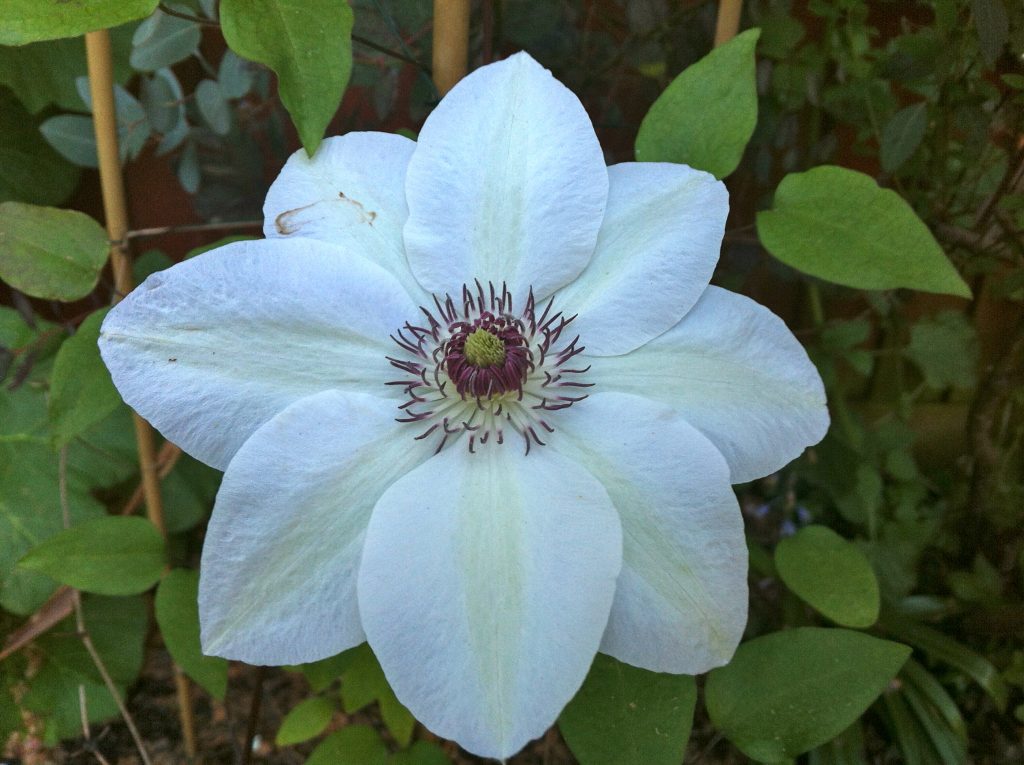
Clematis Miss Bateman Description
Despite the fact that the flower can be planted in the ground throughout the warm season, the period is considered optimal when stability in positive temperatures is observed in spring.
It is also allowed to hold an event in the fall, only in this case it is necessary to pay attention to the weather forecast. Before the onset of nighttime cold snaps, it should be at least 30 days.
Seat selection
The first thing that is taken into account when determining the location of the shrub is the occurrence of groundwater. Delicate clematis is extremely sensitive to moisture stagnation.
Also, for comfortable growth and active growth, the Miss Bateman variety requires a lot of light, while light shading also does not hurt. With insufficient insolation, a loss of saturation with leaf plates is observed.
The best option is to plant a plant near garden trees, which will also act as protection from drafts and gusts of wind.
Preparation of planting material
It is better to purchase planting material in specialized nurseries, which guarantees the purchase of really high-quality goods. For sale are provided mainly either 2-year-old grown seedlings, or one-year-old rooted cuttings - in groups in containers or in a single copy.In the first option, it is worth carefully examining the external characteristics of the leaves and shoots, they should be visually healthy without any defects. When choosing a cutting, the root system is examined. The roots are ideally characterized by elasticity and be present in an amount of at least 3 pieces.
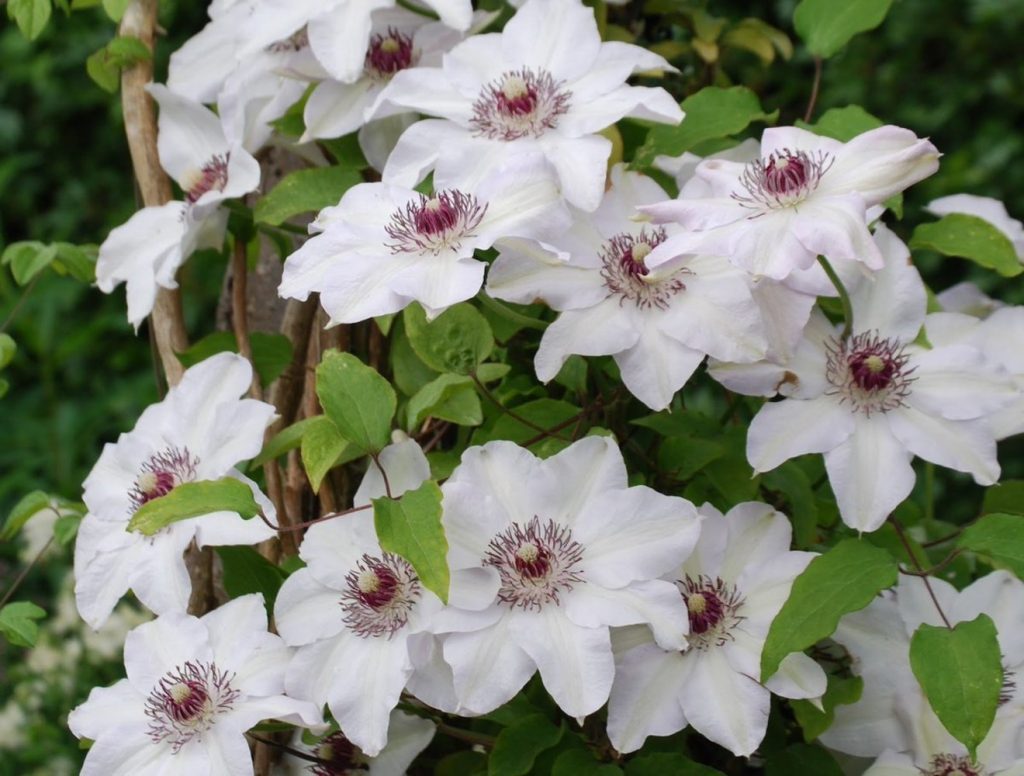
Clematis Miss Bateman
It is recommended to immerse the roots of the plant in a clay mash before planting. If it is necessary to soak an earthen lump, the rhizome is soaked in plain water for 2-3 hours.
Soil requirements
Another factor affecting the active development of a plant is the substrate. In connection with the requirements of Clematis, it must be:
- fertile, with a high humus content;
- breathable;
- with a neutral or slightly alkaline environment.
Landing technology
Scheme of planting a seedling in open ground:
- In a previously dug up substrate, a recess with a size of 0.6 * 0.6 * 0.6 m is made.If a group of plants is supposed to be planted, the planting pits are placed at a distance of 15 cm from each other.
- Lay out a drainage layer 15 cm high from gravel, crushed stone or chipped bricks.
- Stick in the support.
- Fill the well by ½ of the total volume of the soil mixture, add 1 liter of wood ash and 100 g of mineral fertilizer.
- A seedling is installed, while the roots are carefully straightened.
- The rest of the soil is poured so that the lower kidney is open and a bowl-type depression of 8-12 cm remains, into which fertile soil is periodically poured over the summer.
- Water (a bucket of water is enough).
- Mulch with peat.
Care
To ensure rapid growth and abundant flowering, the shrub needs regular watering, feeding and systematic pruning.
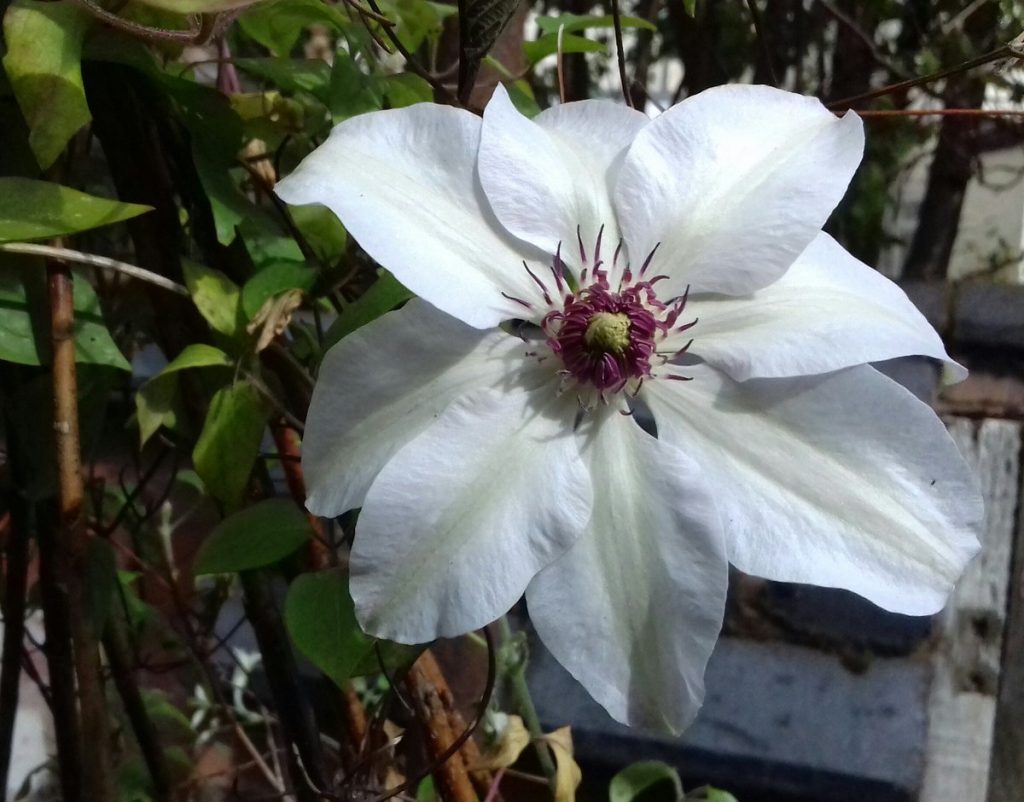
Clematis Miss Bateman Photos
Top dressing
The first year after Clematis was planted by Miss Bateman, there is no need for nutrients as the main food was included in the potting mix.
In the next season, the plants begin to feed with mullein diluted with water in a ratio of 1:10, or with a mineral complex. In the latter case, the drug is taken at the rate of 20 g per 10 liters of liquid.
To achieve the maximum effect, it is recommended to alternate organic matter with other types of fertilizers. On average, it is allowed to carry out the procedure 3-5 times per year.
Watering
Clematis is watered quite often - about 3 times a week, subject to dry weather. The water is used warm, previously settled. From 1 to 2 buckets of liquid are consumed per plant, taking into account the characteristics of the soil - the substrate should be saturated with moisture about 50 cm deep.
Loosening and mulching
Mulch the near-stem space near Clematis in order to slow down the process of evaporation of moisture from the soil and prevent the growth of weeds. It is preferable to take horse manure or rotted peat as a material. The use of wood chips, sawdust or straw is also allowed.
Some gardeners plant stunted annuals in the immediate vicinity, trapping liquid in the ground. However, in this case, regular weeding and loosening of the upper layer is necessary after each irrigation.
Pruning
Clematis Bateman belongs to the plants with the second pruning group. Experts do not recommend carrying out a cardinal haircut in the fall so that the shrub can bloom next year in the spring. Only in the first year after planting on the culture, all shoots are cut off, except for one.
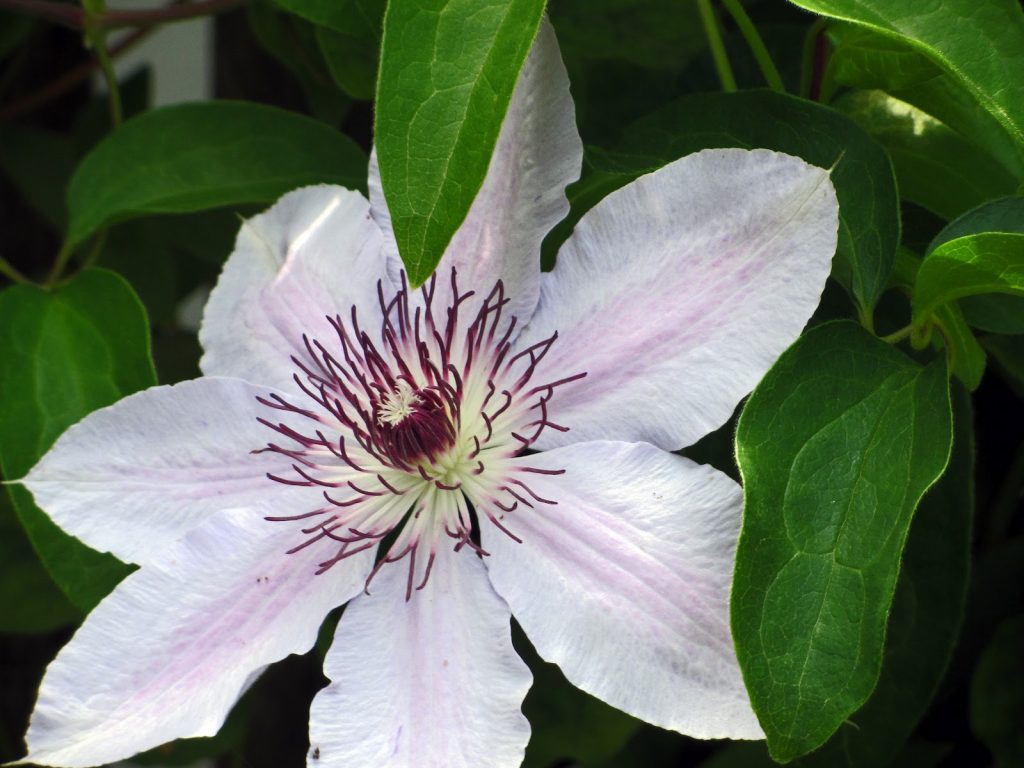
Clematis hybrid miss bateman
Also, faded shoots are regularly removed in the summer, and after the growing season they are shortened, taking into account climatic features. In warm regions, they cut very little, in zones with severe winters, they make a more serious correction.
Shelter for the winter
This type of Clematis is characterized by a high degree of frost resistance, with light protection it hibernates quite comfortably at -25 ° C. The plant is suitable for growing in the Urals and the entire territory of the Middle Belt.Cultivation in the northern regions requires careful shelter for the winter.
The shrub is covered in several stages:
- Sprinkle the base of the plant with plant compost or humus.
- Spray with a fungicidal preparation, sprinkle with wood ash.
- When the temperature drops to minus 6 degrees, the surface of the soil is covered with spruce branches / dry leaves.
- The branches are carefully twisted, wrapped in a non-woven material, and laid on a substrate. It is strictly forbidden to use the film, because it does not allow air to pass through and ultimately leads to decay.
- Cover with spruce branches and slate on top.
Reproduction
Cuttings
The most common breeding method for Clematis. A part of the shoot up to 20 cm long is used as a material. Leaf plates are removed from it by ⅓, and then placed in the ground for rooting. The substrate is pre-sprinkled with a layer of river sand, moistened, covered with polyethylene on top and regularly ventilated.
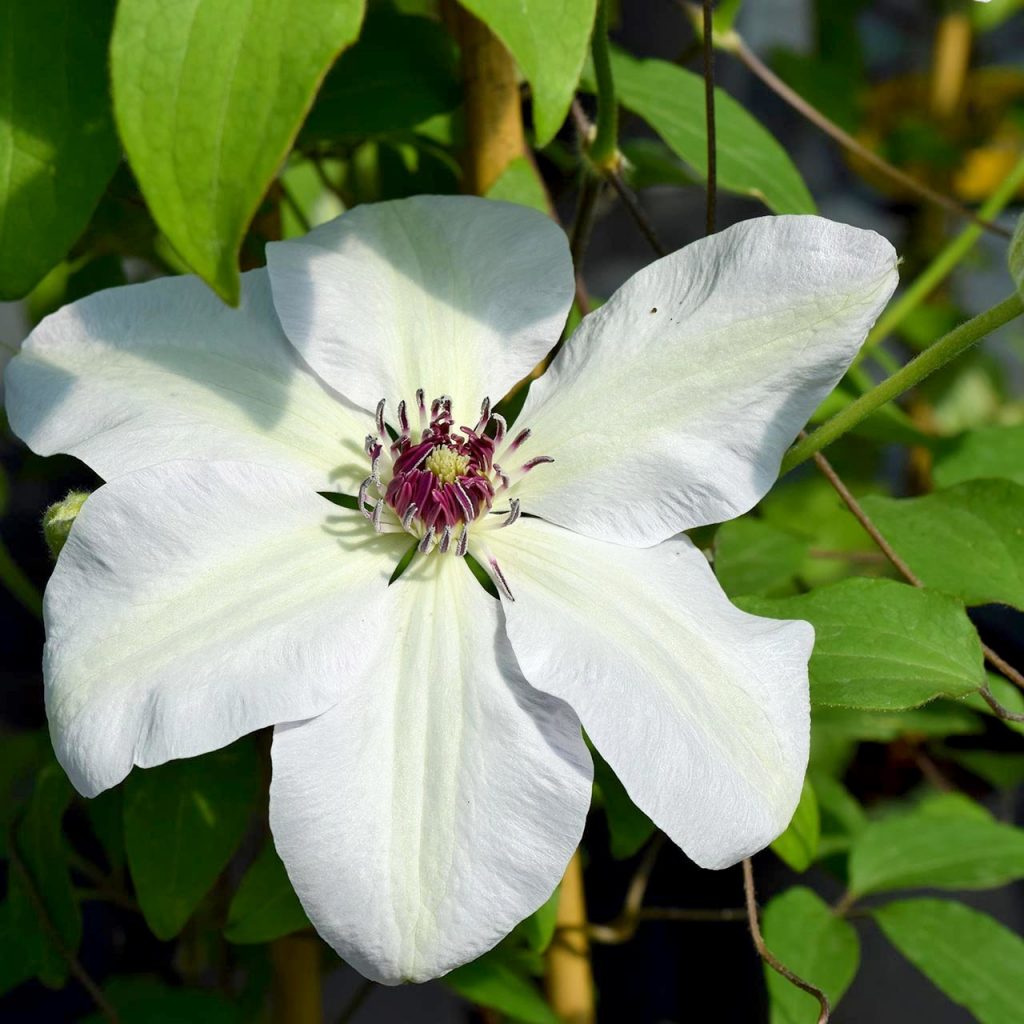
Clematis miss bateman photo and description
Layers
To obtain a young plant, the lower branch of the plant is bent to the ground, sprinkled with a layer of earth of 5-7 cm and fixed. In the fall, the rooted young bush is separated from the mother and moved to a permanent place.
By dividing the bush
Dividing a vine is a laborious process that is little in demand among gardeners. During the procedure, the plant is divided into several parts using a sharp shovel, each of which must contain at least one fresh shoot and a portion of the rhizome.
Diseases
| Name | Symptoms | Prophylaxis | Treatment |
| Verticillosis (Wilt) | The plant begins to wither gradually, shoots die off unevenly, leaves dry. An unpleasant fermentation odor appears. The leaf plates between the veins acquire a brown tint. On the cut during trimming, dark points of the vessels are visible. | They do not allow the soil to dry out excessively; they take exceptionally warm water for irrigation. It is forbidden to use fresh manure as a fertilizer; during the season, it is fed about 3 times with phosphorus-potassium preparations. The nearby territory is weeded in a timely manner (wilt often spreads on weeds), plant residues are disposed of. | Folk methods: infusion of tobacco, chamomile, wood ash. Biological agents: Glyocladin, Trichodermin, Fitosporin-M. Chemicals: Fundazol, Previkur, Vitaros. |
| Gray rot | Grayish fluffy bloom, loss of turgor and saturation by leaves. At the next stage of the disease, mold appears, which leads to the softening of plant tissues and the death of plant parts. | They observe the irrigation regime, loosen the soil, during planting they maintain the recommended distance between the seedlings. | With minor foci: 200 ml of wood ash, 200 ml of chalk and 1 tsp are diluted in 10 liters of water. copper sulfate. The prepared product is enough for 3-4 sq.m. With a large-scale lesion: spray with Bordeaux liquid at a concentration of 1%. |
| Rust | Red or brown oval pads on the back of the leaf, the latter later dry up and fall off. | Agrotechnical rules for the care of the crop are strictly observed, they are treated with fungicides. | Folk ways: For 4 liters of water add 1 tablet of aspirin, 1 tsp. dishwashing detergents, 1 tbsp each sunflower oil and baking soda (sprayed every 7 days). Systemic drugs: Vectra, Cumulus, Cuproxat, Medex, Skor, Strobi. |
| Powdery mildew | Small white spots on the surface that increase in size as the disease progresses. | Avoid crowding plantings, weed regularly, use disinfected tools for pruning, and moderately apply nitrogen fertilizers. | Remove all yellowed and sluggish parts of the plant, treat it abundantly with fungicides (Fundazol, Fundazim, copper sulfate, Topsin-M, Tsineb, Vitaros). |
Pests
| Insect | Signs | Prophylaxis | Control measures |
| Nematodes | Growth paused; leaf curling is observed in warm weather. The leaf plates are covered with light yellow spots, which eventually acquire a brown tint. | They are treated with Nematofagin, and calendula is planted nearby. | Chemicals: Vidat, Nemaphos, Nemagon, Bazamid. |
| Spider mite | White, translucent cobweb on the underside of the leaves, light dots on the surface. | Do not dry out, spray with garlic infusion. | Systemic means: Tiovit-Jet, Fufanon-Nova, Fitoverm, Iskra-Bio. |
| Aphid | Light bloom resembling scales, sticky trail. Leaves turn yellow, deformed. | Anthills are eliminated in a timely manner, birds are attracted to the sites, and weeding are done regularly. | Traditional methods: infusion of garlic, tomato tops, chamomile decoction, soapy water. Means with a chemical composition: Deciss, Fitoverm, Confidor, Iskra. |
| Chafer | Insect larvae have a thick, twisted body of white or yellow hue with a rounded head and 3 pairs of legs. They are initiated only when digging the earth. | Insectivorous animals and birds are attracted, white clover and lupins are sown nearby. | Industrial drugs: Nemabakt, Bazudin, Antichrushch, Zemlin. Folk methods: water the soil with infusion on onion peels. |
Use in landscape design
Clematis Miss Bateman is mainly used to decorate the site as a vertical detail. The plant will decorate both an arch or a gazebo, and a full-fledged building with an unsightly facade. Also, some growers plant crops in close proximity to old stumps, shrubs, fruit trees.
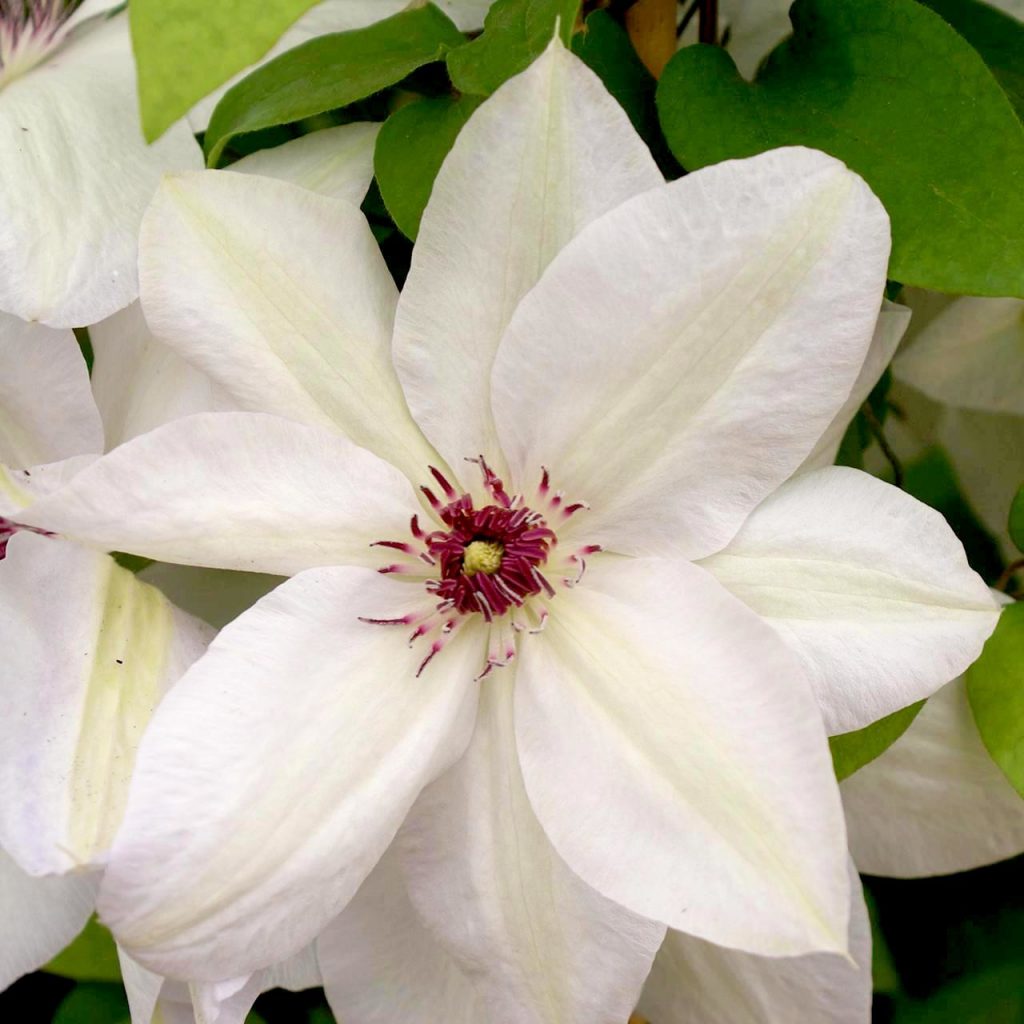
Clematis pruning by miss bateman
Testimonials
Gardeners speak positively about this Clematis variety. They note the unpretentiousness of the plant and the extraordinary beauty of flowers that delight the eye throughout the growing season.

